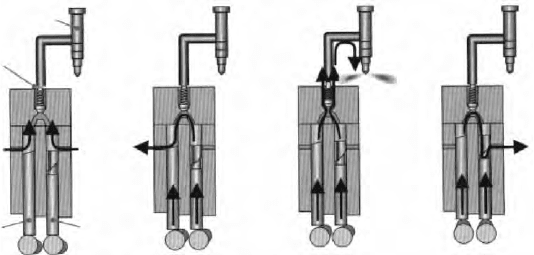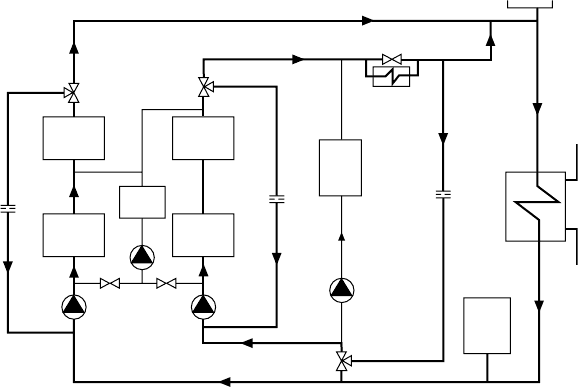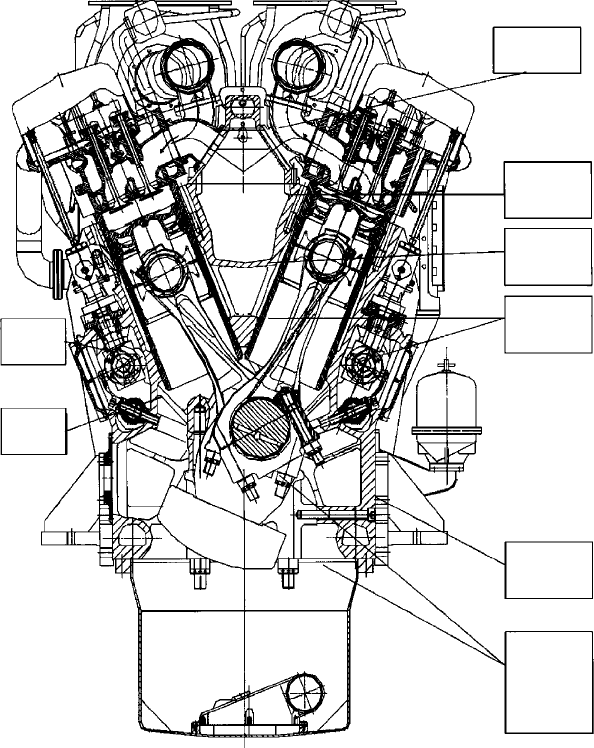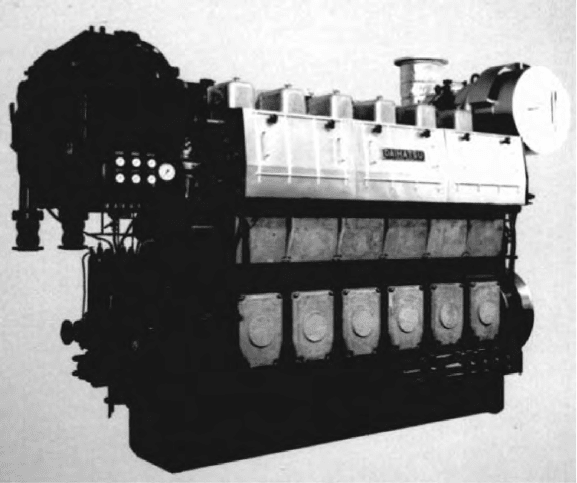Woodyard D. (ed.) Pounders Marine diesel engines and Gas Turbines
Подождите немного. Документ загружается.


710 Wärtsilä
it to control the injection timing during engine operation. New possibilities thus
opened up for controlling different load modes and fuel qualities, even allowing
injection retardation when lower NOx emission values are demanded.
A contribution to reliability by the fuel pump design comes from splitting
the plunger loading between two cams and rollers, thus lowering the loading
on these components and underwriting safe operation at injection pressures up
to 2000 bar. The associated tappets for these components are both integrated in
the same housing as the tappets for the inlet and exhaust valves.
The high-pressure fuel system was designed and endurance tested at
2000 bar; an actual injection pressure of around 1400 bar thus represents
a substantial safety margin. No lubricating oil is required for the pump ele-
ment because the plunger has a wear-resistant low-friction coating. A profiled
plunger geometry keeps the clearance between the plunger and barrel small,
allowing only minimal oil to pass down the plunger; the small leakage is col-
lected and returned to the fuel system. Any chance of fuel mixing with the lube
oil is eliminated. Both the nozzle and nozzle holders are made of high-grade
hardened steel to withstand the high injection pressures and, combined with oil
cooling of the nozzles, to foster extensive nozzle lifetimes.
Low-pressure fuel system safety is underwritten by the Wärtsilä-patented
multi-housing concept. The fuel line consists of channels drilled in cast parts
which are clamped firmly on the engine block and connected to each other by
simple slide-in connections for ease of assembly and disassembly. The pumps
are connected together to form the complete low-pressure fuel line with both
feed and return channels; any need for welded pipes is eliminated. Safety is
further enhanced by housing the entire low-pressure and high-pressure systems
in a fully covered compartment.
Turbocharging system: based on non-cooled turbochargers with inboard
plain bearings lubricated from the engine’s lube oil system. The Spex turbo-
charging system is standard, with the option of exhaust waste gate or air bypass
4
321
Injector
Delivery valve
Timing
plunger
Quantity
plunger
– tappets on cam base
circle
– filling of injection pump
– quantity plunger shuts
off spill port
– excessive fuel out to
low pressure side
through filling port
– both ports are shut off
– delivery valve lifts
– start of injection
– spill port opens
– excessive fuel out to
low-pressure side
through spill port
– end of injection
Figure 27.33 Functions of twin plungers of fuel pump for the Wärtsilä 64 engine

according to the application. Spex, which exploits the pressure pulses without
disturbing the cylinder scavenging, is described in the section Wärtsilä 46. The
interface between the engine and turbocharger is streamlined, eliminating all
the adaptation pieces and piping formerly used.
Cooling system: split into separate HT and LT circuits (Figure 27.34). The
cylinder liner and cylinder head temperatures are controlled through the HT cir-
cuit; the system temperature is kept at a high level (around 95°C) for safe igni-
tion/ combustion of low-quality heavy fuels, including operation at low loads. An
additional advantage is maximum heat recovery. To further increase the recov-
erable heat from this circuit, it is connected to the HT part of the double-stage
charge air cooler. The HT water pump is integrated in the pump cover module at
the free end of the engine; the complete HT circuit is thus virtually free of pipes.
The LT circuit serves the LT part of the charge air cooler and the built-on
lube oil cooler. It is fully integrated with engine parts such as the LT water
pump with pump cover module, the LT thermostatic valve with the lube oil
module and transfer channels in the engine block. In addition, the LT circuit
provides separate cooling of the exhaust valve seats and a lower seat/valve tem-
perature, thus promoting long lifetimes for these components. Directly driven
pumps ensure safe operation even during a short power cut.
Lubricating oil system: all W64 engines are equipped with a complete
built-on lube oil system comprising:
l Pump cover module: engine-driven main screw pump with built-in
safety valve; pre-lubricating module; electrically driven pre-lubricating
screw pump; pressure regulating valve; and centrifugal filter for lube oil
quality indication.
Air separator
Heat
recovery
Central
cooler
Exp.
0.7–1.5
bar
75°C
Valve
seats
95°C
55°C
Luboil
cooler
Charge
air cooler
HT
Charge
air cooler
LT
Pre-
heating
38°C
Cylinder
jacket
Figure 27.34 Cooling water system of Wärtsilä 64 engine
Wärtsilä 64 711
712 Wärtsilä
l Lubricating oil module: lube oil cooler; oil thermostatic valves; full flow
automatic filter; and special running-in filters before each main bearing,
camshaft line and turbocharger.
On in-line cylinder engines the lubricating oil module is always located at
the back side of the engine, while on V-engines it can be built on the engine at
the flywheel or free end, depending on the turbocharger position. The lube oil
filtration is based on an automatic back-flushing filter requiring minimal main-
tenance and no disposable filter cartridges.
Automation system: an engine-integrated system, WECS, is standard and
has these main elements:
l The main control unit (MCU) cabinet, which comprises the MCU itself,
a relay module with back-up functions, a local display unit (LDU), con-
trol buttons and back-up instruments. The MCU handles all communica-
tion with the external system.
l The distributed control unit (DCU) handling signal transfer over a CAN
bus to the MCU.
l The sensor multiplexing units (SMU) transferring sensor information to
the MCU.
Software loaded into the system is easily configured to match the instru-
mentation and the safety and control functions required for each installation.
The MCU cabinet is well protected and built into the engine; most of the
remaining hardware is housed in a special electrical compartment alongside
the engine.
W64 in-service experience
Observations made at the 12 000-h overhaul of the first Wärtsilä 64 engine in
marine service (a seven-cylinder model) revealed no evidence of heavy carbon
deposits on the cylinder head flame deck. Excellent behaviour was indicated by
the exhaust valves, with no failure or burn marks on the contact surface with the
seat ring and no sign of wear or corrosion on the valve stem. The wear on the
ring grooves fell within the permitted limit, promising an expected lifetime of at
least 86 000 h; only minor carbon deposits were noted on the ring grooves (aver-
aging 60 microns on the first groove, and no deposits on the other two grooves).
Lube oil consumption and its quality, especially in an engine running on
heavy fuel oil, is a useful indicator of wear. The anti-polishing ring used on
all Wärtsilä engines ensured that consumption and wear of the piston top and
liner upper part remained low. Good lube oil quality also results in less carbon
deposits on the piston crown-cooling gallery, and consequently the absence of
hot corrosion problems on top of the piston crown.
The connecting rods inspected showed no fretting marks on the mating sur-
face and no cavitation marks on the oil feeding channels. The big end bearings
(tri-metal type) proved to work very well without cavitation or fretting; some
scratches were found on the running surface but the overlay had worked well.
The extensive use of integrated channels adopted in the W64 design contrib-
uted to a lack of oil leakage anywhere around the installation; similarly, the
absence of piping reduces problems during overhauls.
A few failures were reported, however, some resulting from a combination
of second-order causes:
Fuel injection equipment: some problems emerged in the sealing and minor
components on the injection valve and were addressed in cooperation with the
supplier, allowing the nozzle lifetime to be extended up to 7000 h.
Cylinder head stud: failures on two installations were caused by poor qual-
ity in the material and the production process (rolling of the large M110
6 size thread) combined with high flexural vibration. It is unlikely that any
of these factors alone would have caused the failure. A new damping device
tested on the prototype engine yielded lower vibration levels and was adopted.
Intermediate gear stud: three cases of failure were logged, the prob-
lem solved by reducing the free length of the stud stem. A stem support was
integrated on the structure and helped to achieve the targeted reduction in
stud stress.
COMMON rAiL eNgiNeS
Wärtsilä claims to have pioneered the application of computer-controlled CR
fuel injection systems operating on heavy fuel, its developments for medium-
speed engines starting in 1997 and the first deliveries following in 2000.
Numerous installations are now in service and CR fuel injection can be speci-
fied throughout the programme for all models except the W64 engine. The sys-
tem is described earlier under the W46F section and more fully in Chapter 8.
See Chapter 2 for Wärtsilä 32 and 50 dual-fuel engines; Chapter 3 for
Enviroengine versions of the W32 and W46 designs; and Chapter 8 for
Wärtsilä’s common rail fuel injection system.
Common rail engines 713
715
C h a p t e r | t w e n t y e i g h t
Other Medium-Speed
Engines
AnglO BElgiAn COrpOrAtiOn
Two medium-speed engine series are fielded by the Anglo Belgian Corporation
(ABC) for propulsion and auxiliary power applications. The 242 mm bore/
320 mm stroke DX type is produced in three, six and eight in-line cylinder ver-
sions to cover an output band up to 883 kW at 720 or 750 rev/min. DX models
are naturally aspirated; DXS models are turbocharged; and DXC models are
turbocharged and intercooled.
The DZ type is a 256 mm bore/310 mm stroke design offered in six and
eight in-line and V12- and V16-cylinder form to serve power demands up to
3536 kW at 720/750/800/900 and 1000 rev/min. The turbocharged/intercooled
engine is designed for burning heavy fuel with suitable adaptation. Its nodu-
lar cast iron piston features a Hesselman-type head which is oil cooled by the
shaker effect, and four rings: a chrome fire ring, two compression rings and an
oil scraper ring located above the floating piston pin.
The cylinder liner is produced from a wear-resistant centrifugal cast iron
slightly alloyed with chromium. The slightly alloyed cast iron cylinder head
is fitted with two inlet and two Stellited exhaust valves. An intermediate deck
assures a forced water circulation around the valve seats and the centrally
mounted fuel nozzle. The one-piece crankshaft, forged from 42CrMo4 steel
and with induction-hardened running surfaces, is arranged in a box-type crank-
case of nodular cast iron. An additional bearing on the flywheel side limits
crankshaft deflection and bearing wear.
ABC effectively doubled the power threshold of its programme in 2000
with V-cylinder variants of the in-line DZ design, the new V12 and V16 mod-
els offering outputs of 2650 kW and 3536 kW at 720–1000 rev/min (Figure
28.1). A 45° V-bank was selected, fostering an overall width of 1.65 m; an
engine height of 2.5 m is quoted, with lengths of 4.18 m and 4.94 m respec-
tively for the V12 and V16 models. As much commonality of parts as possible
with the in-line cylinder models was sought in the development, but new com-
ponents were designed to permit a 20 per cent rating rise in the future and to

716 Other Medium-Speed Engines
support a peak cylinder pressure of 150 bar. Easy accessibility to parts needing
frequent control or regular preventative maintenance was also pursued.
DAihAtSu
A Japanese contender in the domestic and international small-bore medium-
speed engine arenas, Daihatsu evolved its current programme from the PS
series which was developed in 1950 and helped establish the company as a
major supplier of auxiliary diesel engines. Some 10 000 examples of the PS-26
model, for example, were sold worldwide.
The PS was succeeded in 1967 by a second-generation engine, the DS
series, whose development goals focused on high output, low specific fuel con-
sumption and compactness for genset and main engine roles. Market demands
Cover charge
air manifold
Integrated
charge air
manifold
Stiff
intermediate
deck
Integrated
water inlet
manifold
Cross
Bolting main
bearing cap
Hydraulic
tightened
main bearing
cap studs
and conrod
studs
Camshaft
tunnel
Main oil
gallery
FigurE 28.1 V-version of Anglo Belgian Corporation’s DZ engine

for higher fuel economy with the capability to burn lower-grade bunkers led
to the introduction of a third generation engine, the longer stroke DL series,
which includes eight medium-speed models with bore sizes ranging from
190 mm to 400 mm and covering an output band up to 4415 kW. The DL series
remained in the production programme alongside the fourth generation DK
series, designed to address requirements in the 1990s for high reliability, dura-
bility and extended service intervals.
The DK series (Figure 28.2) embraces 200 mm, 260 mm, 280 mm, 320 mm
and 360 mm bore medium-speed models covering power demands up to
6325 kW at 600/720/750/900 rev/min from in-line and V-cylinder models.
The engine is based on a one-piece cast iron frame designed and manu-
factured for high rigidity to minimize noise and vibration. Large crankcase
windows are arranged on both sides to ease access for maintenance. The
thick bore-cooled flame plate of the cylinder head seeks improved mechani-
cal and heat resistance, and an extended service life. The head is secured by
four hydraulically tightened studs. The crankshaft incorporates hardened large
diameter pins and journals forged in one piece and supported by heavy-duty
bearings for durability. The connecting rod is formed from three pieces with
horizontal joints to reduce piston overhauling height and yield high rigidity.
A gap between the DK-20 and DK-28 models was filled by the 260 mm
bore/380 mm stroke DK-26, intended as a genset drive or propulsion plant for
small ferries, cargo vessels and tugs. Produced as in-line five- and six-cylinder
models, the design develops up to 1710 kW at 720/750 rev/min.
Daihatsu 717
FigurE 28.2 Daihatsu DK-28 engine in six-cylinder form

718 Other Medium-Speed Engines
Similar design principles to the previous DK models are exploited by
the DK-26, notably a high stroke/bore ratio of 1.46:1, but the engine fea-
tures an improved combustion chamber profile and higher compression ratio.
Combustion is claimed to be stable over the entire load range when operating
on heavy fuel, without compromising NOx emission and fuel consumption per-
formance. The engine frame is fitted with deep mounting feet with I-contour
sections so that rubber elements for resilient supports can be attached directly
to the feet. The charge air manifold, lubricating oil gallery and cooling water
passages are all integrated in the frame, creating a double-wall configuration to
help reduce noise and vibration.
A simple yet efficient exhaust layout designated Daihatsu single-pipe
(DSP) exhaust system recovers gas energy effectively by allowing a good
match to the turbocharger. An NOx emission level of 9.4 g/kW h and a specific
fuel consumption of 185 g/kW h at full load are claimed, with temperatures of
key combustion chamber components well within the optimum range.
Supplied with matching gearboxes, the DKM series is produced in 200 mm,
250 mm, 260 mm, 280 mm and 360 mm bore sizes in six- and eight-cylinder
models covering an output band from 880 kW to 4413 kW at speeds from
900 rev/min to 600 rev/min.
A new auxiliary engine, the DC-17, was introduced in 2001 in five- and
six-cylinder versions offering generator outputs of 440 kW and 560 kW at
900/1000 rev/min. The 170 mm bore/270 mm stroke design is released for
heavy fuel-burning applications.
Blending experience from the DK-series and the DC-17 engine, Daihatsu
subsequently developed a 320 mm bore version of the latter. Six- and eight-cyl-
inder variants of this DC-32 design deliver outputs of 2905 kW and 3884 kW
at 720/750 rev/min. A significant reduction in the number of overall parts con-
tributed to the designers’ goals of compactness, simplicity and light weight,
Daihatsu DC-32 data
Bore, mm 320
Stroke, mm 400
Stroke/bore ratio 1.25:1
Cylinders
6/8l
Output, kW 2905/3844
Speed, rev/min 720/750
piston speed, m/s 9.6/10
Mean eective pressure, bar 23.9/25.1
P
max
, bar 177
Weight (dry), kg
35 000/40 000
ease of installation and maintenance, high reliability and durability, low oper-
ating costs and environmental friendliness. Swift withdrawal of a complete
unit assembly (cylinder head, piston, connecting rod and liner) is facilitated,
although conventional dismantling of the individual elements is possible.
Engine frame: a cast iron high-tensile monobloc structure incorporating
inlet air, oil and coolant passages, and arranged for underslung main bearings
with hydraulically tightened main and side bolts. The gearcase is attached to
the front of the frame, along with the turbocharger, air cooler, oil cooler, cool-
ing water pump, oil pump and filter.
Crankshaft and bearings: the continuous grain flow forged crankshaft fea-
tures increased crankpin and journal diameters for optimized surface pressure
and oil film thickness. Large-capacity weights are applied for better rotational
balance adjustment and reduced vibration. The flywheel is attached to the rear of
the shaft, and the gears for the camshaft and pumps are mounted at the other end.
The main and crankpin bearings are of a special corrosion- and wear-resistant
aluminium alloy with a thrust metal attached to the flywheel side No.1 bearing.
Camshaft and timing gears: air inlet valve, exhaust valve and fuel injec-
tion cams are arranged on a large diameter unit camshaft built in two-cylinder
sections. The camshaft timing gear is attached to the front end of the engine,
positioned between the crank gear and cam gear. Each gear is surface hardened
for durability.
Cylinder liner: the thick-walled liner of high-wear resistance cast iron is
bore cooled, the water-cooling only its upper part and the passages optimized
for even water distribution. An anti-polishing ring (termed a ‘liner protect ring’
by Daihatsu) is incorporated at the top of the liner to reduce lube oil consump-
tion and liner wear, extending maintenance intervals and liner life.
Piston and connecting rod: the composite piston features a steel crown
and a nodular cast iron skirt, with the grooves for the top and second rings
induction surface hardened for durability. Effective forced piston cooling is
performed by oil passing through the connecting rod and piston pin. The hori-
zontally cut three-piece rod design allows the piston to be overhauled without
removing the crankpin bearing section; it also reduces the height necessary for
piston withdrawal.
Cylinder head and valves: a special high-strength cast iron improves the
durability of the head which is fastened to the engine frame by four hydrau-
lically tightened bolts. The twin inlet and twin exhaust valves are fitted with
rotators. The water-cooled exhaust valve seats are attached directly to the cyl-
inder head. The fuel injection valve and the surrounding area at the centre of
the head are cooled by the tornado cooling method (Daihatsu patent), allow-
ing non-cooled valves to be used even for heavy fuel operation. Piping on and
around the head is eliminated to ease maintenance.
Fuel injection: Bosch-type high-pressure injection pumps with built-in
tappets and a closed-type plunger barrel are used, with a pressure valve incor-
porated in the fuel outlet valve. The non-cooled heat-treated injectors are con-
nected to the pumps by a forged high-pressure pipe.
Daihatsu 719
720 Other Medium-Speed Engines
Turbocharging and exhaust system: the DSP exhaust system, promoting
a higher turbocharging efficiency and simplicity, is located on the same side
as the inlet air duct for easier maintenance of the manifold and bellows. The
number of components is reportedly 40 per cent fewer than in a conventional
system. A two-stage air cooler facilitates charge air heating at low engine loads.
Freshwater cooling system: split into separate high-temperature and low-
temperature circuits; a two-stage intercooler system benefits combustion when
burning heavy fuel at low loads. The main cooling water outlet pipes for the
engine cylinders are connected by sliding flanges for ease of dismantling.
Lube oil filter: an automatic, continuous back-flushing filter serves both
engine and turbocharger, eliminating the need for an extra filter for the latter.
Daihatsu has developed a common rail fuel injection system for the DK-
series and has investigated two-stage turbocharging systems in conjunction
with the Miller cycle for applications calling for very low NOx emissions.
grAnDi MOtOri triEStE
A wide range of medium-speed engines were designed and produced over
many years by Grandi Motori Trieste (GMT), which was founded in the late
1960s to pool the diesel engine expertise and resources of Fiat, Ansaldo and
CRDA, and rationalize the Italian engine-building industry. GMT later became
part of the state-owned Fincantieri shipbuilding group’s diesel engine division
and in 1997 entered a new era as a member of the Wärtsilä Corporation (see
Chapter 27), after which its own design portfolio was phased out.
GMT’s last large engine, the A55 series, was the final evolution of a
550 mm bore model first designed and produced in Torino by Fiat Grandi
Motori in the early 1970s. The original A550 design with a 590 mm stroke and
a rating of 880 kW/cylinder was developed into a B550 version with an out-
put of 1080 kW/cylinder at 450 rev/min. The BL550 derivative (Figure 28.3),
launched in 1986, retained the same bore size and running speed but exploited
a longer stroke (630 mm) to yield a 10 per cent higher output and a reduc-
tion in specific fuel consumption on low-grade fuel. The power uprating—to
1213 kW/cylinder—was achieved with a modest increase in mean effective
pressure (from 20.6 bar to 21.6 bar) and a rise in mean piston speed from
8.85 m/s to 9.45 m/s.
Higher mechanical and thermal loads dictated some changes in the design
of combustion chamber elements and running gear but the engine frame and
bedplate remained separate units of nodular cast iron for the in-line cylinder
engines. Unlike the original design, the eight- and nine-cylinder bedplates and
frames are monobloc castings secured by tie-rods; however, the V-type engines
feature a welded steel bedplate and a special cast iron frame for which tie-rods
are unnecessary and replaced by stud bolts.
The cylinder head for the BL550 engine (Figure 28.4) was redesigned to
assure a more even distribution of temperatures between the exhaust valves and
the fuel nozzle, and additional bore cooling introduced in the gas-side walls
